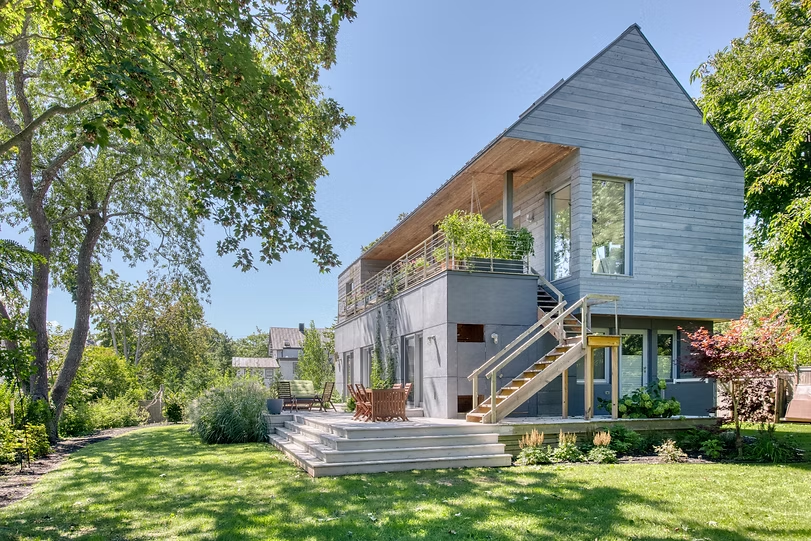An Exclusive Tour Inside The Greenport Passive House

How one designer created a chic Greenport Passive House that’s as healthy as it is beautiful
By Chere Di Boscio
Imagine waking up in a sun-drenched loft with sweeping views of nature, crisp, clean air filling your lungs. And knowing your home is not just beautiful, but healing.
For architect Wayne Turett, that dream became reality with the creation of his stunning Greenport Passive House. It’s a modern, all-electric masterpiece nestled on the North Fork, overlooking Sterling Harbor Basin.
From the moment you step inside Turett’s eco-forward sanctuary, it’s clear this isn’t just a vacation home. Rather, it’s a living, breathing example of what sustainable architecture can be.
Light streams through oversized windows, cathedral ceilings soar, and every detail whispers luxury. But it’s what’s behind the walls that makes this home extraordinary.
The secret? Passive house design. And in this case, a very stylish one.

What Is a Passive House?
The Greenport Passive House is part of a global architectural movement that started in Germany in the 1980s. Known as Passivhaus, the approach focuses on airtight construction, super insulation, and high-efficiency ventilation. It was all designed to minimise the need for traditional heating and cooling.
Compared to most homes, Turett’s creation uses up to 90% less energy for heating. “It’s all about sealing the envelope,” he explains. It means keeping conditioned air in, and pollutants and drafts out.
The inspiration struck during a stay at a passive home in Berlin. “It was a real eye-opener,” he says. “You could have a gorgeous modern space with huge windows and still be incredibly energy efficient.”
Three years later, Turett completed his Greenport Passive House, which now serves as both a full-time retreat and a model for others seeking a healthier, lower-impact lifestyle.
Why Greenport Was the Perfect Location
Turett has long been drawn to Long Island’s North Fork. He’s owned several homes in the area over the decades, but the Greenport Passive House was his first ground-up build. It was designed not just as an escape from the city, but as a sustainable showcase.
Greenport offers the perfect blend of quiet, natural beauty and community-minded living. Local farms, vineyards, and sailing spots make it easy to embrace a healthy lifestyle that aligns perfectly with the ethos of passive house living.


Health Benefits of a Passive House
While the energy savings are impressive, what Turett loves most about his Greenport Passive House is how healthy it feels.
His decision to go completely gas-free wasn’t just environmental; it was personal. “Gas appliances introduce toxic waste into the home,” he says. “Cooking produces carbon monoxide, and unless ventilation isn’t top-notch, you’re breathing that in.”
Instead, his all-electric home is powered by clean energy and features an Energy Recovery Ventilation (ERV) system that’s constantly circulating fresh, filtered air throughout the space.
When you’re inside, it’s like living in a deep-breathing, toxin-free cocoon. It’s fresh in the summer, cozy in the winter, and always calm.

How Passive Homes Stay Comfortable Year-Round
Designed “upside down,” with bedrooms on the cooler ground floor and a loft-like living space upstairs, the Greenport Passive House also harnesses natural light and seasonal sun angles for maximum comfort. In winter, the sun’s lower arc pours warmth into the home; in summer, overhangs protect the space from overheating.
There are no solar panels (yet). But the home is solar-conscious by design. And with its sculptural lighting, artful ductwork, and elegant finishes, and eco friendly insulation, it’s proof that sustainable living doesn’t mean sacrificing style.


Small Changes You Can Make at Home
You don’t need to build a custom home like Greenport Passive House from scratch to enjoy the benefits of a passive house. Turett believes every home can be a little healthier and more sustainable with a few smart upgrades. Some of his suggestions are below.
✅ Book an energy audit
Find air leaks and energy drains. Some utilities offer these for free (check out LongIslandGreenHomes.org for New York homeowners).
✅ Seal your envelope
Weatherproof doors and windows, and consider upgrading old ones. Insulate with eco-friendly materials like mineral wool or cellulose instead of chemical foams.
✅ Upgrade your ventilation
Install an ERV or HRV (Heat Recovery Ventilation) unit to circulate fresh air while maintaining comfort during the winter. No open windows needed!
✅ Choose low-VOC materials
Opt for paints, flooring, and furnishings that don’t “off-gas” harmful chemicals into your home.
✅ Use charcoal air filters
Add them to your HVAC system for an easy indoor air quality boost.
A Realistic Vision for Greener Living
Today, Turett is expanding his architectural work on the North Fork, helping others design greener homes inspired by his Greenport Passive House philosophy. But he knows change takes time.
“You can’t push people into this,” he says. “But when they see the benefits: cleaner air, smaller HVAC systems, lower bills and so on. They get it.”
Even small steps matter. “It doesn’t have to be all or nothing,” he says. “I’m all for incremental change.”
With homes like the Greenport Passive House leading the way, that change is looking more stylish — and more possible — than ever before.
All photos thanks to Liz Glasgow
- An Exclusive Tour Inside The Greenport Passive House - July 14, 2025
- Upcycled Bathroom Storage Ideas To Try - July 7, 2025
- WIN A Vegan Bag By Monade Worth Over $200 - July 4, 2025









